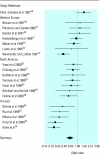Prevalence of Helicobacter pylori in patients with gastro-oesophageal reflux disease: systematic review
- PMID: 12676842
- PMCID: PMC152634
- DOI: 10.1136/bmj.326.7392.737
Prevalence of Helicobacter pylori in patients with gastro-oesophageal reflux disease: systematic review
Abstract
Objectives: To ascertain the prevalence of Helicobacter pylori in patients with gastro-oesophageal reflux disease and its association with the disease.
Design: Systematic review of studies reporting the prevalence of H pylori in patients with and without gastro-oesophageal reflux disease.
Data sources: Four electronic databases, searched to November 2001, experts, pharmaceutical companies, and journals.
Main outcome measure: Odds ratio for prevalence of H pylori in patients with gastro-oesophageal reflux disease.
Results: 20 studies were included. The pooled estimate of the odds ratio for prevalence of H pylori was 0.60 (95% confidence interval 0.47 to 0.78), indicating a lower prevalence in patients with gastro-oesophageal reflux disease. Substantial heterogeneity was observed between studies. Location seemed to be an important factor, with a much lower prevalence of H pylori in patients with gastro-oesophageal reflux disease in studies from the Far East, despite a higher overall prevalence of infection than western Europe and North America. Year of study was not a source of heterogeneity.
Conclusion: The prevalence of H pylori infection was significantly lower in patients with than without gastro-oesophageal reflux, with geographical location being a strong contributor to the heterogeneity between studies. Patients from the Far East with reflux disease had a lower prevalence of H pylori infection than patients from western Europe and North America, despite a higher prevalence in the general population.
Figures


Comment in
-
Helicobacter pylori in gastro-oesophageal reflux disease needs comparator.BMJ. 2003 Jun 28;326(7404):1460. doi: 10.1136/bmj.326.7404.1460. BMJ. 2003. PMID: 12829575 Free PMC article. No abstract available.
References
-
- Jones R. Gastro-oesophageal reflux disease in general practice. Scand J Gastroenterol Suppl. 1995;211:35–38. - PubMed
-
- Office of Health Economics. Health expenditures in the UK. London: Stationery Office; 1996.
-
- Hosking SW, Ling TK, Chung SC, Yung MY, Cheng AF, Sung AF, et al. Duodenal ulcer healing by eradication of Helicobacter pylori without anti-acid treatment: randomised controlled trial. Lancet. 1994;343:508–510. - PubMed
-
- Graham DY, Yamaoka Y. H pylori and cagA. Relationships with gastric cancer, duodenal ulcer, and reflux esophagitis and its complications. Helicobacter. 1998;3:145–151. - PubMed
-
- Richter JE, Falk GW, Vaezi MF. Helicobacter pylori and gastroesophageal reflux disease: the bug may not be all bad. Am J Gastroenterol. 1998;93:1800–1802. - PubMed
Publication types
MeSH terms
LinkOut - more resources
Full Text Sources
Medical
